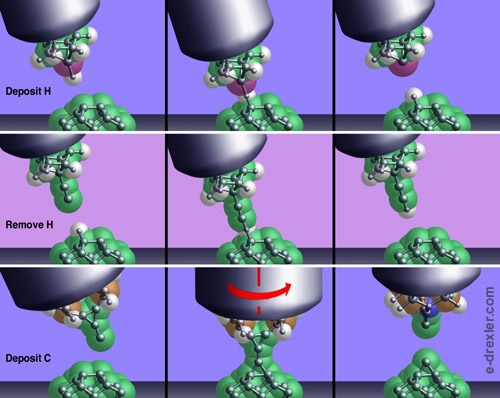
Putting the “Science” in “Science Fiction” – Nanotech Part 3 – Nanotech Manufacturing
Nanotechnology offers many possibilities that will change the way people live their daily lives. Out of all these possibilities, the one that will create the most changes is the use of nanotechnology in manufacturing. Most theoretical uses of nanotech manufacturing rely on nanotech’s ability to interact with materials on the molecular or even atomic scales to perform a theoretical process called mechanosynthesis. This process is similar to chemosynthesis, which is the current method of creating most basic materials, but is far more precise. Chemosynthesis works by mixing materials together in a fluid or gas, using temperature and motion to combine the elements. This technique is used in all current manufacturing, but is limited in what it can do. Mechanosynthesis, on the other hand, relies on using nanoscale technology to mechanically place molecules together. Being able to do this will offer much finer control over creating materials, while greatly reducing the occurrence of unwanted reactions, and it will allow the creation of materials that were previously thought to be impossible to manufacture. This technology will open up entirely new possibilities when it comes to manufacturing techniques.

Research into performing mechanosynthesis is ongoing, and it will take a great deal of refinement before it becomes feasible to mass produce the technology, but its possible applications are staggering. As this technology becomes more sophisticated and economically feasible, it will revolutionize almost every industry and change the way the economy operates. Current experiments are only beginning to show the promise of this technology, and using nanotechnology to fuse carbon into artificial diamonds is simply one example of this research. Scientists are already using this technology to create materials with diamond-like wear resistance for use in nanotechnology. The creation of artificial diamonds, once perfected, will be useful in many industrial and electronic applications. Although creating diamonds is certainly an impressive achievement, scientists working in this field have set their sights even higher: they dream of creating materials with similar strength to steel but weighing 50 times less, astoundingly powerful computers built on the molecular level, and other amazing constructions.
The creation of entirely new materials is not the only goal of nanotech manufacturing, and many people see a perfected version of it changing how all manufacturing is done. Factories using nanotechnology could theoretically produce almost any material with greater precision than any current industrial process. Due to the method in which this manufacturing process would work, it would be possible to build factories small enough to fit on a desktop that could build almost any object given time, resources and the proper programming. This could lead to a potential shift in the entire way in which manufacturing is performed, with people downloading or even creating the blueprints for objects they want and then constructing them at home. Non-nanotech versions of this technology already exist with desktop 3D printers, and this could even lead to systems like Star Trek’s replicators, which can produce almost any material as soon as it is ordered. Even at a less advanced stage, these devices could change the world economy permanently, help to provide for the billions of poor and suffering people around the world, and allow ordinary individuals to express their creativity in an almost limitless fashion. Imagine a world where a person can design their own shoe, action figure, Christmas ornament, or almost anything else, including its colour and the material it is made of, and then have it constructed by the desktop factory sitting next to their monitor. Although this vision is certainly promising, we still haven’t reached the potential limit of nanotech manufacturing.

Perhaps the pinnacle of nanotech manufacturing involves combining it with nanorobotics. Although such a dream is a long way off, it has almost limitless possibilities. One example: nanolathing, where a target area is sprayed with either a carefully constructed series of molecular particles or even nanobots in order to instantly create a structure. Another even more amazing possibility is utility fog, a cloud of nanobots that can attach to each other in different combinations and instantly change shape at the user’s command. Such a cloud could theoretically form almost any structure as long as it was of a sufficient size, and some science-fiction works suggest that this technology could replace almost all other technologies once it is mastered. Researchers are eagerly striving to make this exciting possibility a reality.
Our mastery of nanotechnology may never reach the heights predicted in science-fiction, but even primitive nanotech manufacturing processes promise to change the world in astounding ways. If this technology is ever adopted on a large scale, it could have a greater impact on society than any other technology – even the computer! Although the possibilities nanotech manufacturing opens up are amazing, the potential for abuse is high and so, as always, it is every person’s duty to use these technologies responsibly.














